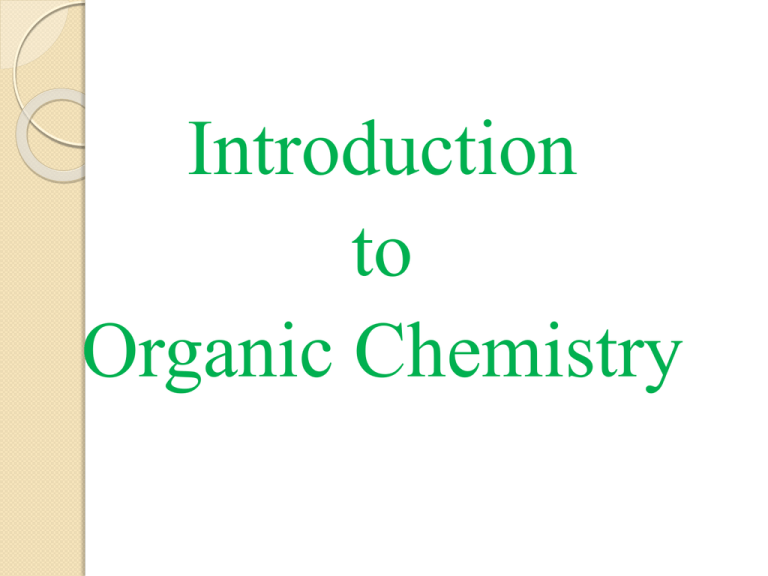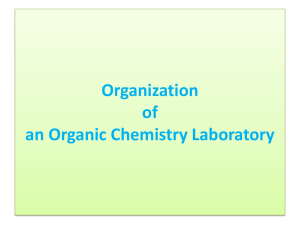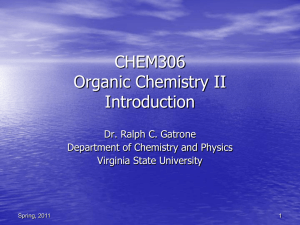Organic chemistry involves the study of the structures, properties
advertisement

Introduction to Organic Chemistry WHAT IS ORGANIC CHEMISTRY? ORGANIC CHEMISTRY INVOLVES THE STUDY OF THE STRUCTURES, PROPERTIES, COMPOSITION, REACTIONS AND PREPARATIONS( BY SYNTHESIS OR OTHER MEANS) OF CHEMICAL COMPOUNDS CONSISTING PRIMARILY OF CARBON AND HYDROGEN (HYDROCARBON), WHICH MAY CONTAIN ANY OTHER ELEMENTS (DERIVATIVES OF HYDROCARBON) INCLUDING NITROGEN, OXYGEN, HALOGEN. Historical Development of Organic Chemistry Ancient medicines Jesus turning water into wine Soap from animal fat Extracts of plants and animals into dyes, perfumes, make-up, inks and fibers woven to clothes The main sources of organic compounds are living matter and they were all found to contain the elements carbon and hydrogen. Investigation revealed that during burning they produced carbon dioxide and water substances. The Vital Force Theory states that organic compounds could be manufactured only by and within living matter and that they could never be synthesized from inorganic materials was very popular then. Torben Bergman (1770) first to make distinction between organic and inorganic chemistry Friedrich Wohler, 1828 Synthesis Urea from ammonium cyanate Carl Scheele Purified various plants acids such as citric, tartaric, succinic, Lactic, and malic acid and characterized their salts Pierre-Joseph Pelletier and Joseph Bienaime Caventou, 1818-1820 Identified the alkaloids strychnine and quinine from plants Antoine Laurent Lavoisier Showed that organic compd produces CO2 and H2O during Combustion; carried the first elemental analysis or organic compd Joseph Louis Gay- Lussac and Jons Jacob Berzelius, 1810-1815 Developed Lavoisier combustion method of Organic analysis Joseph Louis Gay-Lussac Jons Jacob Berzelius Justus von Liebig, 1831 Created a faster, extraordinary , accurate and comfortable method of organic analysis Jean- Baptiste-Andre Dumas, 1826-1833 Developed a precise method to determine vapor densities Of organic compds and improved way to measure their nitrogen content; developed new theories of organic composition Jons Jacob Berzelius Named the concept of polymerism and isomerism; Regarded electrostatic attraction as the force that held the pieces of molecules together. August Kekule, 1857-1858 Developed the theory of chemical structure. According to him C atom can bond together to form a C skeleton that constitutes the framework of the molecule Emil Fisher Organized an effective investigation of the Chemistry of sugars and proteins Adolf von Baeyer Explored complex natural products such as dye molecules and terpenes Linus Pauling Give the resonance interpretation of the benzene ring Which provided the first truly static factory understanding of aromatic chemistry. 20th century - stereochemistry, development of synthetic methods, structure determinations, synthesis of important natural products and articulations of theories of composition matured 1930’s onward - instruments developed because of the revolution of analytical chemistry (UV-VIS, IR, pH meter, mass spectrophotometer, GC, NMR, GC-NMR, electron spin resonance, x-ray diffraction) “ Much of the interesting work being done today in organic chemistry still happens in reaction flasks and beakers. There is still art in this work.” The current major advances in Organic Chemistry technology concerns the synthesis of (1) novel polymers for highly specific uses, (2) drugs initially "designed" by molecular modeling & synthesized by combinatorial methods. (3) Rare or complex biologically important compounds (such as proteins and genes) & (4) the development of synthetic processes which exploit the versatility and specificity of isolated and purified enzymes ("enzymes as reagents"). This is so-called "green chemistry" and attempts to produce commodity chemicals in ways that are far less harmful to the environment than previously done. Thus, even to be a biochemist, one has to be an organic chemist first! Importance of Organic Chemistry 1. Medicines are another important factor in the health and well-being of man. Specific examples of medicine are common antibiotics like penicillin (C16H17N2O4SNa) and streptomycin (C12H39N7O12). These are widely used in the treatment of communicable diseases like tuberculosis, pneumonia, venereal diseases and other infections. 2. Organic chemicals have been responsible for the rapid increase in food production to meet the demands of an expanding world population. The two famous substances that generally /greatly helped in these developments were the insecticide DDT( C14H9Cl5, dichloro-diphenyl-trichloroethane) and the herbicides 2,4-D (C8H6Cl2O3). But DDT have been discovered to have an adverse ecological effects. Therefore, it is now important to discover insecticides which would surpass the effectiveness of DDT and be reasonably biodegradable (organic matter degraded or decomposed by aerobic bacteria in conjunction with other aerobic organisms) so that they do not accumulate and poison the ecosystem. 3. Considering the various and confusing contribution of organic chemistry as a science, a study of this subject helps one in solving problems systematically by digging into their causes and reasons to be able to find best solutions. Learning and organizing abilities will be developed to be able to relate and interpret proper information. Furthermore, it could enhance or increase imaginative thinking and develop critical outlook in man to be able to come up with sound conclusions from the gathered evidenced or data. As a whole, it could help in the development of the wholesomeness of the person. Are all carbon containing compounds organic? No. Not all carbon containing compound are organic. Carbon dioxide, carbon monoxide, cyanide, carbonates, bicarbonates are examples. Note that these exceptions do not contain hydrogen to the carbon atom, the basic requirement for the classification of organic compounds.








